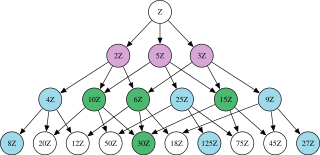Semiprime ring

In ring theory, a branch of mathematics, semiprime ideals and semiprime rings are generalizations of prime ideals and prime rings. In commutative algebra, semiprime ideals are also called radical ideals.
For example, in the ring of integers, the semiprime ideals are the zero ideal, along with those ideals of the form where n is a square-free integer. So, is a semiprime ideal of the integers, but is not.
The class of semiprime rings includes semiprimitive rings, prime rings and reduced rings.
Most definitions and assertions in this article appear in (Lam 1999) and (Lam 2001).
Definitions
For a commutative ring R, a proper ideal A is a semiprime ideal if A satisfies either of the following equivalent conditions:
- If xk is in A for some positive integer k and element x of R, then x is in A.
- If y is in R but not in A, all positive integer powers of y are not in A.
The latter condition that the complement is "closed under powers" is analogous to the fact that complements of prime ideals are closed under multiplication.
As with prime ideals, this is extended to noncommutative rings "ideal-wise". The following conditions are equivalent definitions for a semiprime ideal A in a ring R:
- For any ideal J of R, if Jk⊆A for a positive natural number k, then J⊆A.
- For any right ideal J of R, if Jk⊆A for a positive natural number k, then J⊆A.
- For any left ideal J of R, if Jk⊆A for a positive natural number k, then J⊆A.
- For any x in R, if xRx⊆A, then x is in A.
Here again, there is a noncommutative analogue of prime ideals as complements of m-systems. A nonempty subset S of a ring R is called an n-system if for any s in S, there exists an r in R such that srs is in S. With this notion, an additional equivalent point may be added to the above list:
- R\A is an n-system.
The ring R is called a semiprime ring if the zero ideal is a semiprime ideal. In the commutative case, this is equivalent to R being a reduced ring, since R has no nonzero nilpotent elements. In the noncommutative case, the ring merely has no nonzero nilpotent right ideals. So while a reduced ring is always semiprime, the converse is not true.[1]
General properties of semiprime ideals
To begin with, it is clear that prime ideals are semiprime, and that for commutative rings, a semiprime primary ideal is prime.
While the intersection of prime ideals is not usually prime, it is a semiprime ideal. Shortly it will be shown that the converse is also true, that every semiprime ideal is the intersection of a family of prime ideals.
For any ideal B in a ring R, we can form the following sets:
The set is the definition of the radical of B and is clearly a semiprime ideal containing B, and in fact is the smallest semiprime ideal containing B. The inclusion above is sometimes proper in the general case, but for commutative rings it becomes an equality.
With this definition, an ideal A is semiprime if and only if . At this point, it is also apparent that every semiprime ideal is in fact the intersection of a family of prime ideals. Moreover, this shows that the intersection of any two semiprime ideals is again semiprime.
By definition R is semiprime if and only if , that is, the intersection of all prime ideals is zero. This ideal is also denoted by and also called Baer's lower nilradical or the Baer-Mccoy radical or the prime radical of R.
Semiprime Goldie rings
References
- ↑ The full ring of two-by-two matrices over a field is semiprime with nonzero nilpotent elements.
- Lam, Tsit-Yuen (1999), Lectures on modules and rings, Graduate Texts in Mathematics No. 189, Berlin, New York: Springer-Verlag, ISBN 978-0-387-98428-5, MR 1653294
- Lam, T. Y. (2001), A first course in noncommutative rings, Graduate Texts in Mathematics, 131 (2 ed.), New York: Springer-Verlag, pp. xx+385, ISBN 0-387-95183-0, MR 1838439